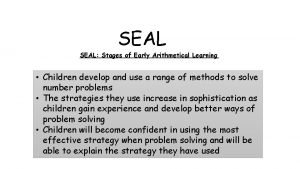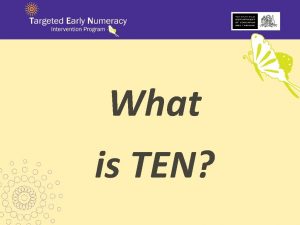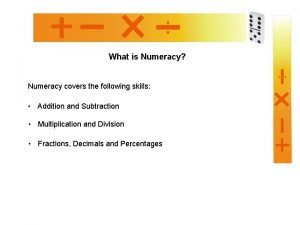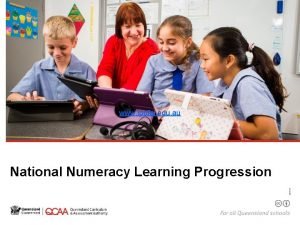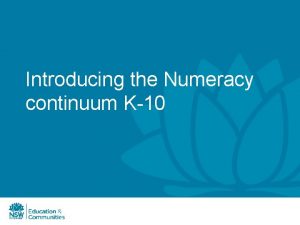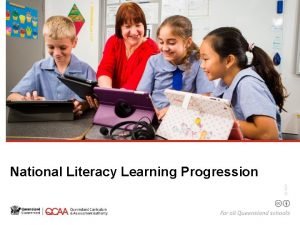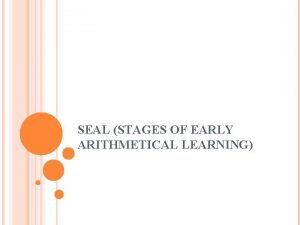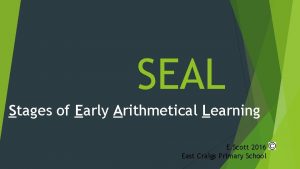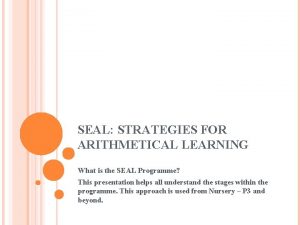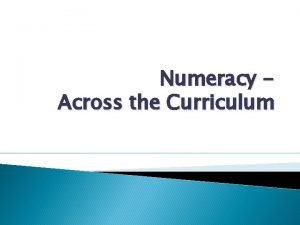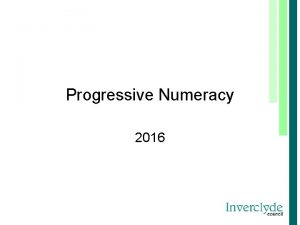Numeracy SEAL Stages of Early Arithmetical Learning An








- Slides: 8

Numeracy - SEAL (Stages of Early Arithmetical Learning)

An example… 6+5 = 11 o Concrete items o Count from 1… o Count on from 6… o Jump strategy (6+4+1) o Double strategy …All strategies vary in sophistication; SEAL aims to gradually teach children readily available strategies to select for problems like these.

SEAL : Numeracy Scheme • reduces any gaps in children’s understanding of numeracy • introduces children to progressively more sophisticated techniques to use when solving mathematical problems • starts with visual and concrete items before introducing abstract techniques • emphasis on asking children about the strategies they use, this allows them to choose the most effective one for them and also to learn from others in the class (provides an opportunity for you to check their understanding)

SEAL : Lesson Organisation 1. Whole class introduction 2. Differentiated groups circulate: one group with me, one with a PSA, one completing an independent task 3. Whole class plenary; summarise learning • tasks differentiated to suit the needs of learners

Emergent Children • attempt to count to 20 • begin to learn number words and recognise numerals • begin to associate number words with a number of items • we help children say forward and backwards number word sequences and identify number before and after • encourage counting items in different ways • show children how to sequence numbers • introduce children to different ways of representing numbers: finger patterns, spatial patterns, temporal patterns • discuss their strategies

Perceptual Children • can count percieved items • begin to create perceptual replacements for abstact problems • help children say forward and backwards number word sequences and number before and after to 30 • encourage adding two collections: introduce screening • describe spatial patterns/represent finger patterns in different ways • moving towards abstract representation • help children group/share items (division) • takeaway on their fingers • provide opportunities to talk about strategies

Figurative Children • counting and representing items to 100 • can add two unseen collections • begin to solve more sophisticated problems (missing number and takeaway sums) • encourage adding two collections in different ways – introduce children into ‘counting on’ strategies • provide opportunities to talk about and share their strategies

SEAL : Active Learning • programme provides lots of opportunities for active learning: children really enjoy it! • hands on activities, I aim to make numeracy learning as fun and as engaging as possible… • examples of resources are out on the tables… feel free to have a look around ask me any questions!
 Stages of early arithmetical learning
Stages of early arithmetical learning Stages of early arithmetical learning
Stages of early arithmetical learning Targeted early numeracy intervention program
Targeted early numeracy intervention program Incremental increase method questions
Incremental increase method questions Numeracy stages
Numeracy stages Literacy progressions version 3
Literacy progressions version 3 Numeracy learning continuum
Numeracy learning continuum National literacy and numeracy learning progressions
National literacy and numeracy learning progressions Early cpr and early defibrillation can: *
Early cpr and early defibrillation can: *

